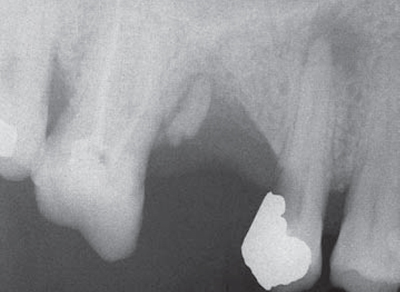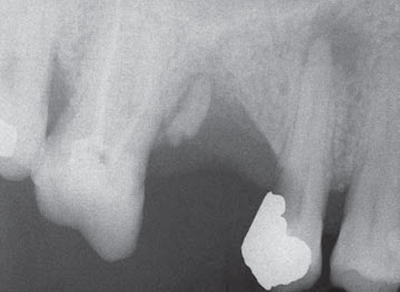SECTION 7
TOOTH RESTORATION WITH ENDODONTIC TECHNIQUES

REASON FOR PROCEDURE
Any event that places the pulp tissue within the root canal of a tooth at risk of inflammation or infection may eventually lead to the death of that tooth. Once a tooth has died, it is a source of either painless chronic infection or acute and very painful infection, neither of which are amenable to the oral health of a patient.
Events that can result in the inflammation of the pulp (pulpitis) include the following:
- Deep caries lying close to, or exposing, the pulp (see Figure 7.1)
- Thermal injury
- Chemical irritation from restorative materials
- Trauma, which may be severe enough to cause tooth fracture in some cases
- Prolonged irritation from very deep fillings
Figure 7.1 Radiograph showing deep caries and periapical area

The only methods available to the dentist to remove the symptoms, treat the tooth and save it from extraction are as follows:
- Pulp capping
- Pulpotomy
- Pulpectomy
PULP CAPPING
Background information of procedure
This is a technique carried out as a temporary measure to stabilise the tooth before proceeding to either pulpotomy or pulpectomy to save it from extraction. It is necessary when a small pulp exposure occurs unexpectedly during restorative dental treatment, or when a patient attends as an unscheduled emergency following trauma.
The aim of pulp capping is to seal the exposed pulp from the oral cavity, and the myriad of microorganisms within it, until time allows for a full end-odontic procedure to be carried out to save the tooth.
Details of procedure
If pulp exposure occurs during restorative treatment, it is likely that a local anaesthetic will have been administered previously. If a recent trauma has caused the exposure, the tooth is likely to be concussed and unresponsive to stimulation.
In any event, the tooth must be kept as clean as possible to prevent the introduction of microorganisms into the pulp chamber. Once completed, pulp capping will prevent pain and infection developing before further treatment can be carried out.
Technique
- The dentist, nurse and patient wear personal protective equipment
- The tooth is isolated from saliva contamination using moisture control techniques
- Any bleeding at the exposure site is arrested using sterile cotton wool pledgets, possibly soaked in a local anaesthetic solution containing a vasoconstrictor
- Once bleeding has been arrested and the area is dry, a paste of calcium hydroxide is carefully placed over the exposure site
- The remaining cavity or fracture site is then sealed with a sedative temporary dressing material
PULPOTOMY
Background information of procedure
When trauma occurs to a permanent tooth in a child, it is often the case that the root canal/>
Stay updated, free dental videos. Join our Telegram channel

VIDEdental - Online dental courses


